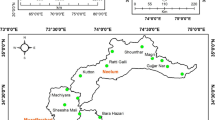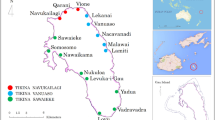Abstract
The study of the interrelationship between ethnomedicinal knowledge and socio-cultural values needs to be studied mainly for the simple reason that culture is not only the ethical imperative for development, it is also the condition of its sustainability; for their exists a symbiotic relationship between habitats and cultures. The traditional communities around Binsar Wildlife Sanctuary of Uttarakhand state in India have a rich local health care tradition, which has been in practice for the past hundreds of years. The present study documents the Ethnomedicinal uses of 54 medicinal and aromatic plants (MAPs) along with their botanical and vernacular names, family, habit, habitat, threat status, collection season, purpose of collection, quantity, conservation practices, market potential and part(s) used in traditional health care system. The documented species belonging to 38 families have been used to cure more than 47 different kinds of ailments. These MAPs collected from the wild in a particular season and used as per the method prescribed by traditional herbal healers (Vaidyas) that provide effective results. Perception of local people during field trips based on socio-demographic characters showed them to prefer herbal system of treatments and they understood the status of traditional health care systems in the region. The study reveals that approximately 70 % population of the study area depend on herbal systems of treatments and preferred to visit Vaidyas for curing a variety of ailments because the traditional system of medicine is one of the most important prevailing systems in the region where modern health care facilities are rare or in very poor conditions. The organic cultivation practices of selected MAPs were demonstrated to rural inhabitants through capacity building training program and participatory action research framework approaches for sustainability and enhancement of livelihood security. A series of workshops and village level meetings on traditional health care systems were organized and forming/registered a strong association of Vaidyas for making their traditional system of health care more practical and effective. The study emphasizes the potentials of the ethnomedicinal research, conservation practices, socio-cultural and religious ethics for promoting traditional plants based treatments and also the need to document the indigenous knowledge for scientific validation before its industrial application.




Similar content being viewed by others
References
Azaizeh, H., Fulder, S., Khalil, K., & Said, O. (2003). Ethnomedicinal knowledge of local Arab practitioners in the Middle East Region. Fitoterapia, 74, 98–108.
Dhyani, D., Maikhuri, R. K., Mishra, S., & Rao, K. S. (2010). Endorsing the declining indigenous ethnobotanical knowledge system of Seabuckthorn in Central Himalaya, India. Journal of Ethnopharmacology, 27, 329–334.
Diallo, D., Hveem, B., Mahmoud, M. A., Berge, G., Paulsen, B. S., & Maiga, A. (1999). An ethnobotanical survey of herbal drugs of Gourma district Mali. Pharmaceutical Biology, 37, 80–91.
Duming, A. T. (1992). Guardians of the earth; indigenous people and the health of the earth, world watch paper no. 112. Washington, DC: World watch Inst.
Duraipandiyan, V., Auyana, M., & Ignacimuthu, S. (2006). Antimicrobial activity of some ethnomedicinal plants used by Paliyar tribe from Tamil Nadu, India. BMC Complementary and Alternative Medicine, 20, 6–35.
Farnsworth, J. D. (1988). Screening plants for new medicines. In E. O. Wilson (Ed.), Biodiversity (pp. 83–97). Washington, DC: National Academy Press.
Gangwar, K. K., Deepali, G. R. S., & Gangwar, R. S. (2010). Ethnomedicinal plant diversity in Kumaun Himalaya of Uttarakhand, India. Nature and Science, 8(5), 66–78.
Gaur, R. D. (1999). Flora of the district Garhwal North West Himalaya with ethnobotanical note, trans media. Garhwal: Srinagar. 109.
Hill, A. F. (1952). Economic botany. Tokyo: McGrow-Hill Book Company, Inc.
Hoffmann, V., Probst, K., & Christinck, A. (2007). Farmers and researchers: How can collaborative advantages are created in participatory research and technology development? Agriculture and Human Values, 24, 355–368.
Kala, C. P. (2002). Indigenous Knowledge of Bhotiya tribal community on wool dying and its present status in the Garhwal Himalaya, India. Current Science, 83, 814–817.
Kala, C. P. (2005). Indigenous uses, population density and conservation of threatened medicinal plants in protected areas of the Indian Himalayas. Conservation Biology, 19, 368–378.
Kala, C. P. (2007). Local preferences of ethnobotanical species in the Indian Himalaya: Implication for environmental conservation. Current Science, 93, 12–25.
Kala, C. P., Farooquee, N. A., & Dhar, U. (2004). Prioritization of medicinal plants on the basis of available knowledge, existing practices and uses value status in Uttarakhand, India. Biodiversity and Conservation, 13, 453–469.
Kala, C. P., Farooquee, N. A., & Dhar, U. (2005). Traditional uses and conservation of timur (Zanthoxylum armatum DC.) through social institutions in Uttaranchal Himalaya, India. Conservation and Society, 3(1), 224–230.
Kandari, L. S., Phondani, P. C., Payal, K. C., Rao, K. S., & Maikhuri, R. K. (2012). Ethnobotanical Study towards conservation of medicinal and aromatic plants in upper catchments of Dhauli Ganga in the Central Himalaya. Journal of Mountain Science, 9, 286–296.
Kloucek, P., Polesny, Z., Svobodova, B., Vlkova, E., & Kokoska, L. (2005). Antimicrobial screening of some Peruvian medicinal plants used in Calleria District. Journal of Ethnopharmacology, 99, 309–312.
Maikhuri, R. K., Nautiyal, S., Rao, K. S., & Saxena, K. G. (1998). Role of medicinal plants in the traditional health care system: A case study from Nanda Devi Biosphere Reserve, Himalaya. Current Science, 75(2), 152–157.
Maikhuri, R. K., Rao, K. S., Chauhan, K., Kandari, L. S., Prasad, P., Rajasekaran, C. (2003). Development of marketing of medicinal plants and other forest products: can it be a path way for effective management and conservation. Indian Forester, 129, 169–177.
Maikhuri, R. K., Rao, K. S., Kandari, L. S., Joshi, R., & Dhyani, D. (2005). Does the outreach program make an impact? A case study of medicinal and aromatic plant cultivation in Uttaranchal. Current Science, 88(9), 1480–1486.
Maikhuri, R. K., Rawat, L. S., Phondani, P. C., Negi, V. S., Farooquee, N. A., & Negi, C. (2009). Hill Agriculture of Uttarakhand: Policy, governance, research issues and development priorities for sustainability. The Indian Economy Review, IIPM, 6(31), 116–123.
Mukherjee, P. K., & Wahile, A. (2006). Integrated approaches towards drug development from Ayurveda and other Indian system of medicines. Journal of Ethnopharmacology, 103, 25–35.
Nabhan, G. P. (1989). Enduring seeds: Native American agriculture and wild plant conservation. San Francisco, CA: North Point Press.
Naithani, B. D. (1985). Flora of Chamoli (Vol. 2, p. 595). Dehradun: Botanical Survey of India.
Narayana, D. B. A., Katayar, C. K., & Brindavanam, N. B. (1998). Original system: Search, research or re-search. IDMA Bulletin, 29, 413–416.
Nautiyal, S., Rao, K. S., Maikhuri, R. K., Semwal, R. L., & Saxena, K. G. (2000). Traditional knowledge related to medicinal and aromatic plants in tribal societies in a part of Himalaya. Journal of Medicinal and Aromatic Plant Sciences 23/4A and 23/1A, 528–441.
Negi, V. S., & Maikhuri, R. K. (2012). Socio-ecological and religious perspective of agrobiodiversity conservation: Issues, concern and priority for sustainable agriculture, Central Himalaya. Journal of Agricultural and Environmental Ethics,. doi:10.1007/s10806-012-9386-y.
Negi, V. S., Maikhuri, R. K., Phondani, P. C., & Rawat, L. S. (2010). An Inventory of indigenous knowledge and cultivation practices of medicinal plants in Govind Pashu Vihar Wildlife Sanctuary, Central Himalaya, India. International Journal of Biodiversity Science, Ecosystem Services and Management, 1, 1–10.
Negi, V. S., Maikhuri, R. K., & Vashishtha, D. P. (2011). Traditional healthcare practices among the villages of Rawain valley, Uttarkashi, Uttarakhand, India. Indian Journal of Traditional Knowledge, 10(3), 533–537.
Phondani, P. C. (2010). A study on prioritization and categorization of specific ailments in different high altitude tribal and non-tribal communities and their traditional plant based treatments in Central Himalaya. Unpublished Ph.D. Thesis submitted to H.N.B. Garhwal Central University, Srinagar, Uttarakhand.
Phondani, P. C. (2011). Worth of traditional herbal system of medicine for curing ailments prevalent across the mountain region of Uttarakhand, India. Journal of Applied Pharmaceutical Science, 1(09), 81–86.
Phondani, P. C., Maikhuri, R. K., & Kala, C. P. (2010a). Ethnoveterinary uses of medicinal plants among traditional herbal healers in Alaknanda catchment of Uttarakhand, India. African Journal of Traditional, Complementary and Alternative Medicines, 7, 195–206.
Phondani, P. C., Maikhuri, R. K., Negi, C. S., Kala, C. P., Rawat, M. S., & Bisht, N. S. (2011a). Indigenous knowledge of medicinal plants among rural communities of Dhutatoli forest range in Pauri district, Uttarakhand, India. In C. P. Kala (Ed.), Medicinal plants and sustainable development (pp. 209–217). Hauppauge, NY: Nova Science Publishers.
Phondani, P. C., Maikhuri, R. K., Negi, V. S., Rawat, L. S., Kandari, L. S., Bahuguna, A., et al. (2011b). Revitalize traditional health care system for sustainable development and medicinal plants conservation in Uttarakhand Himalaya. Environment and We: An International Journal of Science and Technology, 6(3), 155–165.
Phondani, P. C., Maikhuri, R. K., Rawat, L. S., Farooquee, N. A., Kala, C. P., Vishvakarma, S. C. R., et al. (2010b). Ethnobotanical uses of plants among Bhotiya tribal communities of Niti Valley in Central Himalaya, India. Ethnobotany Research and Application, 8, 233–244.
Phondani, P. C., Negi, V. S., Bhatt, I. D., Maikhuri, R. K., & Kothyari, B. P. (2011c). Promotion of medicinal and aromatic plants cultivation for improving livelihood security: A case study from West Himalaya, India. International Journal of Medicinal and Aromatic Plants, 1(3), 245–252.
Planning Commission. (2000). Report of the task force on conservation and sustainable use of medicinal plants. New Delhi: Government of India, Planning Commission.
Prasad, R., & Bhattacharya, P. (2003). Sustainable harvesting of medicinal plant resources. In S. B. Roy (Ed.), Contemporary studies in natural resource management in India (pp. 168–198). New Delhi: Inter-India Publications.
Rana, M. S., & Samant, S. S. (2011). Diversity, indigenous uses and conservation status of medicinal plants in Manali Wildlife Sanctuary, North western Himalaya, Indian. Journal of Traditional Knowledge, 10(3), 439–459.
Sahoo, U. K., Lalremruata, J., Lalramnghinglova, H., Lalremruati, J. H., & Lalliankhuma, C. (2010). Livelihood generation through non-timber forest products by rural poor in and around Dampa Tiger Reserve in Mizoram. Journal of Non-Timber Forest Products, 17(2), 147–161.
Samal, P. K., Shah, A., Tiwari, S. C., & Agrawal, D. K. (2004). Indigenous health care practices and their linkage with bio-resources conservation and socio-economic development in central Himalayan region of India. Indian Journal of Traditional Knowledge, 3(1), 12–26.
Sharma, P. P., & Mujumdar, A. M. (2003). Traditional knowledge on plants from Toranmal Plateau of Maharashtra. Indian Journal of Traditional Knowledge, 2, 292–296.
Sienna, C. (2002). Himalayan Healers in tradition: Professionalization, Identity and Conservation among Practitioners of gso ba rig pa in Nepal. In Proceeding of regional workshop on wise practices and experimental learning in conservation and management of Himalayan medicinal plants Kathmandu, Nepal, pp. 411–433.
Tiwari, L. (2003). Traditional Himalayan medicine system and its materia medica. India: History of Indian Science and Technology.
WHO. (2002). World Health Organization traditional medicine strategy 2002–2005 (p. 12). Geneva: WHO.
Wiersum, K. F., Dold, A. P., Husselman, M., & Cocks, M. (2006). Cultivation of medicinal plants as a tool for biodiversity conservation and poverty alleviation in the Amatola region, South Africa. In R. J. Bogers, L. E. Craker & D. Lange (Eds.), Medicinal and aromatic plants (pp. 43–57). Netherlands: Springer.
Zimmerer, K. S. (1991). Managing diversity in potato and maize fields of the Peruvian Andes. Journal of Ethnobiology, 11, 23–49.
Acknowledgments
The authors are thankful to the Director, G.B. Pant Institute of Himalayan Environment and Development for providing all kinds of institutional facilities. We are grateful to all local people, traditional herbal healers, medical doctors and experts of the study area for their immense co-operation and active participation. The authors would like to thank the anonymous reviewers of an earlier version of this paper for their helpful comments. National Medicinal Plants Board (NMPB), Government of India are also acknowledged for financial assistance.
Author information
Authors and Affiliations
Corresponding author
Rights and permissions
About this article
Cite this article
Phondani, P.C., Maikhuri, R.K. & Bisht, N.S. Endorsement of Ethnomedicinal Knowledge Towards Conservation in the Context of Changing Socio-Economic and Cultural Values of Traditional Communities Around Binsar Wildlife Sanctuary in Uttarakhand, India. J Agric Environ Ethics 26, 573–600 (2013). https://doi.org/10.1007/s10806-012-9428-5
Accepted:
Published:
Issue Date:
DOI: https://doi.org/10.1007/s10806-012-9428-5




